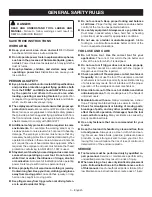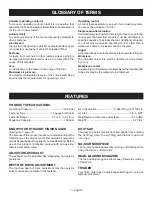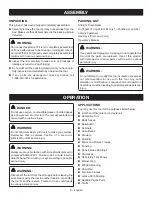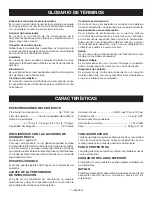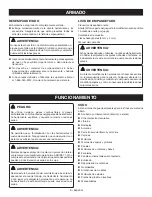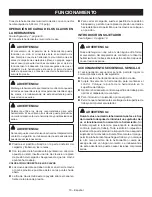
10 – English
OPERATION
WARNING:
Use only the nails recommended for use with this tool.
The use of any other nails can result in tool malfunction,
leading to serious injuries.
WARNING:
Never load nails with the workpiece contact or trigger
activated. Doing so could result in possible serious
personal injury.
Pull the push latch to rear of magazine and lock into slots.
With the nose of the tool pointed away from you, insert
a strip of nails into the magazine on push plate side. Be
sure the nails are pointed downward.
CORRECT NAIL POSITION
Nails should always be inserted with the points downward,
fitting into the nail track, or as close as possible to the
nail track.
Nail strip should be resting on channel in front of push
plate.
To close the magazine, release the push latch from the
locked position and allow push plate to move forward,
pushing the nails into position.
DRIVING A FASTENER
See Figure 8, page 16.
WARNING:
Never wedge or hold back the workpiece contact
mechanism during operation of the tool. Doing so could
result in possible serious injury.
SINGLE SEQUENTIAL ACTUATION
Single sequential actuation provides accurate fastener
placement.
Connect the tool to the air supply.
Grip the tool firmly to maintain control. Position the nose
of the tool onto the work surface.
Push the tool against the work surface to depress the
workpiece contact.
Pull the trigger to drive a fastener.
Allow the tool to recoil away from the work surface as the
fastener is driven.
WARNING:
During normal use the tool will recoil immediately
after driving a fastener. This is a normal function of
the tool.
Do not attempt to prevent the recoil by holding
the nailer against the work. Restriction to the recoil can
result in a second fastener being driven from the nailer.
Grip the handle firmly, let the tool do the work, and do
not place second hand on top of tool or near exhaust at
any time. Failure to heed this warning can result in serious
personal injury.
SETTING THE AIR PRESSURE
The amount of air pressure required will depend on the size
of the nail and the workpiece material.
Begin testing the depth of drive by driving a test nail into
the same type of workpiece material used for the actual job.
Drive a test nail with the air pressure set at 90-95 psi. Raise
or lower the air pressure to find the lowest setting that will
perform the job with consistent results.
It may be possible to achieve the desired depth with air
pressure adjustments alone. If finer adjustments are needed,
use the drive depth adjustment on the tool.
DRIVE DEPTH ADJUSTMENT
See Figure 9, page 16.
The driving depth of the nail may be adjusted. It is advisable
to test the depth on a scrap workpiece to determine the
required depth for the application.
To determine depth of drive, first adjust the air pressure and
drive a test nail. To achieve the desired depth, use the drive
depth adjustment on the tool.
Disconnect the tool from the air supply.
Turn the depth selector left or right to change the driving
depth.
Reconnect the tool to the air supply.
Drive a test nail after each adjustment until the desired
depth is set.
WARNING:
Disconnect the tool from the air supply before removing
nails. Failure to do so could result in serious personal
injury.



